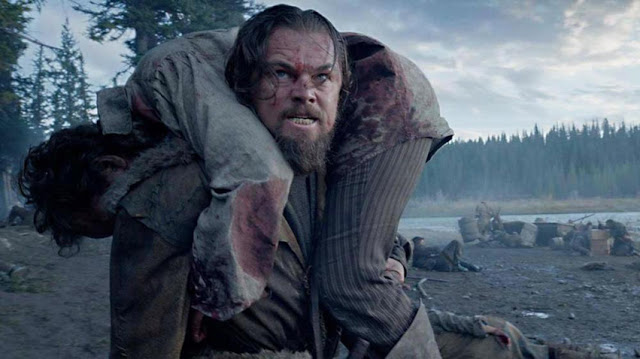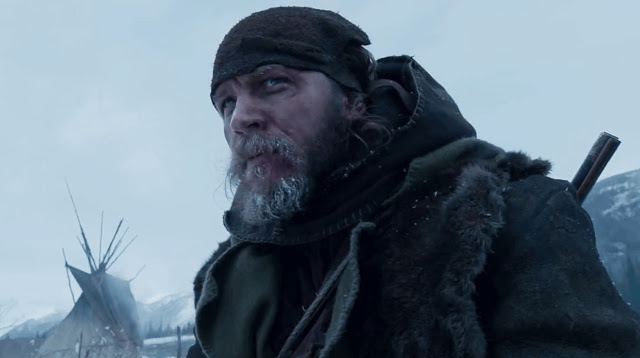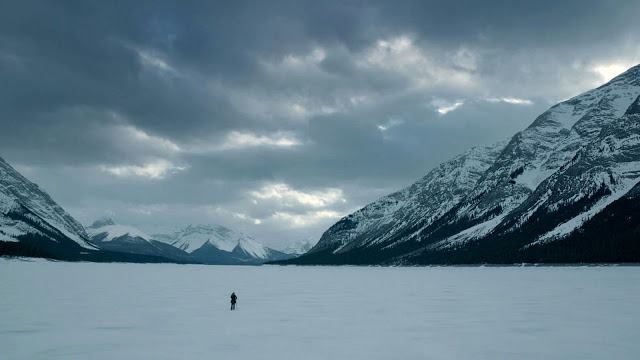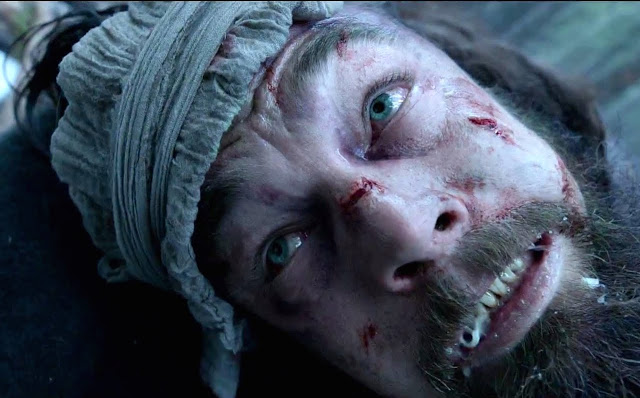The Revenant defies categorization, not because it refuses to serve as a particular type of movie, but because it is so many movies at once. Both art film and action flick, both meditative drama and survivalist thriller, both historical fiction and contemporary allegory—the latest and craziest picture from provocateur Alejandro González Iñárritu wants it all. This level of naked ambition is rare in modern cinema, and it is tempting to praise The Revenant—a two-and-a-half hour adventure film with minimal dialogue and maximal craft—for simply existing. But look past its staggering audacity, and The Revenant reveals itself as a work of true duality, even beyond its mirrored ambitions. It is, in empirical terms, both a good movie and a bad one.
Let’s begin with the bad. Based on a novel by Michael Punke (Iñárritu wrote the screenplay along with Mark L. Smith), The Revenant‘s storyline is exceedingly slight. Set in the early nineteenth century, it follows a band of fur trappers in the American wilderness. Initially, there are roughly 30 of them, but after the native Arikara (dubbed “Ree”) spring an ambush—a characteristically bloody sequence filled with loud musket-fire and zooming arrows—their numbers are reduced to about 10, though only two are of any consequence. They are Glass (Leonardo DiCaprio), an inveterate tracker with a half-Pawnee teenage son, and Fitzgerald (Tom Hardy), a brusque trapper who is as unapologetically selfish as he is culturally insensitive. After Glass is severely wounded by a bear—more on that in a bit—he and Fitzgerald are separated from their unit; not one to loiter with an invalid, Fitzgerald murders Glass’s son and leaves the immobilized Glass for dead. The remainder of The Revenant focuses on Glass’sagonizing efforts to survive in the forbidding wild, driven by his need to enact revenge on his son’s killer.
As narratives go, this is rather thin gruel, and familiar to boot. The Revenant is basically a hybrid of The Last of the Mohicans and Cast Away, albeit filtered through the peculiar prism of Terrence Malick’s The New World. Its characters are archetypes rather than actual men, and it discards plausibility in favor of eye-popping absurdity. Structurally, it proceeds as little more than a series of outrageous combat sequences. Guy fights bear. Guy fights nature. Guy fights guy. The end.
But movies are not so easily reduced to bare-bones plot summaries, and while The Revenant‘s story may be asinine, its execution is consistently spellbinding. Iñárritu is a polarizing director, yet while his Oscar win for Birdman may have been dubious, his success clearly emboldened him to take even greater risks. Here, he has taken one of cinema’s most durable genres—the Western, with its black hats and white hats, its gunfights and machismo—and used it as the scaffolding for an exploratory picture, an opportunity to push the medium past its typical boundaries. He isn’t telling a traditional story (at least, not an interesting one) so much as testing the limits of his own craft. That may make The Revenant self-aggrandizing, but it also makes it fascinating. The film is consistently thrilling to behold, not just for its riveting study of survival, but for its revelatory command of filmmaking grammar.
This is why the real star of The Revenant, despite what you may have seen in advertisements or on the red carpet, is Emmanuel Lubezki. Winner of the past two Oscars for Best Cinematography—first for Alfonso Cuarón’s Gravity, then for Birdman—Lubezki has proven himself a virtuoso with the camera, routinely deploying long, fluid takes that challenge conventional notions of how movies can be made. His work on The Revenant, while less gimmicky than Birdman‘s attention-grabbing theatrics (in which the film deceptively appeared to have been shot in a single take), is even more impressive. Embracing the freedom of digital, Lubezki’s camera is always moving here, but it is never in a rush. It simply glides toward and around its characters, continuously remapping your perception of the frame while also placing you squarely in the center of the action. Many cinematographers favor long takes, but most pick between static widescreen compositions and jittery handheld close-ups. In The Revenant, Lubezki reveals this dichotomy to be a false choice. The movie’s aesthetic is somehow both precise and intense, resulting in a formal approach that is also breathtaking in its intimacy.
Which brings us back to that bear. The film’s unquestioned pièce de résistance, the scene in which an angry grizzly mauls Glass—not once, but twice—is a gobsmacking sequence, both for its unrepentant ferocity and its astonishing technique. (Iñárritu’s special effects team, rendering the bear in remarkably convincing CGI, has done extraordinary work.) Rather than artificially amping up the tension with speedy cuts and jumpy sound editing, Iñárritu lets the moment unfold slowly, almost gracefully, relying on the elegance of Lubezki’s camerawork and the expressive power of his golden-haired lead. The scene is punishing in its brutality, but it is never scarier than when the bear stops attacking Glass, daring the audience to take a collective breath before ratcheting up the violence once more.
It is possible to ascribe metaphorical significance to the bear, a symbol of the might and majesty of nature. Certainly, Iñárritu wishes The Revenant to be more than just a gritty fable of endurance. That’s why he seems to be channeling his inner Malick, complete with scattered bits of voiceover venerating this harsh and beautiful new world, along with occasional apparitions from Glass’s dead Pawnee wife. Ironically, these stabs at naturalistic profundity are the rare moments when the film feels mechanical, the product of an artist flaunting his gifts rather than just using them. But when Iñárritu dials back his pretensions and just speaks with his camera, the results are striking. The Revenant is resplendent with gorgeous, ghoulish imagery: dying orange embers floating up in a cloud of pale-grey smoke; slender pines stretching infinitely into the winter sky; rushing rapids slicing through the snow-bitten landscape.
That landscape proves quite the challenge for Glass, who, over the considerable length of The Revenant, suffers one excruciating ordeal after another. Beyond that little incident with the big bear, Glass must evade a hunting party of (undeveloped) Ree natives, skirmish with some (equally undeveloped) French interlopers, navigate a roaring river while clinging to a single tree branch, and even take shelter inside the body of a freshly dead horse after careening off a cliff. That’s quite the list of labors, but if you’re disputing the credibility of Glass’s herculean efforts, you’re missing the point. Iñárritu is not concerned with realism, nor should he be. His goal is to pay tribute to the stark beauty and merciless cruelty of nature, and to add a new entry into the mythology of the American frontier.
And also, of course, to put one of the country’s prettiest and most charming stars through an especially unforgiving wringer. Much has been written about the extreme lengths DiCaprio went to in order to portray Glass, but even if you’ve ignored the press, you can see his strenuous exertion right there on screen. With a mountain-man beard and spittle caking his mouth, DiCaprio spends a significant portion of the movie tethered to a litter, communicating only with pained wheezes and frenzied eyes. Eventually, he breaks free, though he still spends considerable time sprawled on the ground, dragging his body across the snow toward revenge, salvation, and perhaps that ever-elusive Oscar. He rarely speaks—he certainly never converses with a volleyball—but he acts plenty.
Perhaps too much. The part of Glass is without doubt DiCaprio’s most committed performance, but it is not his most persuasive. Part of this is a matter of taste—I prefer my Leo sporting a smirk rather than a scowl—but it is also a function of the role’s inherent limitations. Glass is more legend than man, and DiCaprio plays him as such, forcibly pummeling us with the enormity of his talent rather than simply letting that talent shine through. It’s a perfectly sensible approach to an outsized character, and it’s assuredly the kind of gigantic performance that Iñárritu demanded. But there is such visibility in DiCaprio’s acting, such obvious toil, that it inadvertently highlights the imperceptible genius of his costar. Hardy is a similarly gifted actor, but his technique is more submerged, and he quietly transforms Fitzgerald into a truly terrifying monster. DiCaprio effectively communicates the cold in The Revenant, but it’s Hardy, with soulless eyes and a guttural drawl that he seems to have borrowed from Ted Levine, who chills you to the bone.
Frigidity is The Revenant‘s default climate—upon exiting the theater, you may rush to huddle under a blanket. But there is also a strange warmth surrounding this reckless, admirable film, a comfort that brave directors are still willing to sacrifice safety in the far-flung hope of achieving immortality. The Revenant doesn’t entirely succeed in its monumental task; its final, primal clash feels mundane rather than poetic, and its narrative shortcomings cannot be ignored. But despite its failures, its lasting impression is one of triumph. With stunning craft and heedless grandeur, it somehow blurs the line between movie and myth.
Jeremy Beck is the editor-in-chief of MovieManifesto. He watches more movies and television than he probably should.




